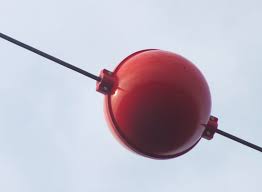In addition to scientific research, the working group also tries to protect the spoonbills and little egrets themselves as much as possible, as well as their habitat. One of the causes of death in spoonbills is caused by collisions with power lines, especially the top two wires, which are the thinnest and therefore least visible.
Due to the placement of their eyes, spoonbills often only see the wires at the last moment. They then try to pull up with their legs going down. The legs then hit the wire, causing them to break. In that case, the spoonbill can sometimes still fly and sometimes reaches the colony, but as soon as it has landed it will die irrevocably. If such a bird is found, you can tell from its legs that it is a ‘wire victim’.

Photo: Kris de Maeyer
The working group has been in discussions with Tennet, the operator of the electricity grid in the Netherlands, for a long time. After all, this concerns large numbers of victims per year and not only among spoonbills. Braaksma (1966) attempted to estimate the number of wire casualties per year from ring data. Greven (1973) did this by counting wire victims under high-voltage lines. It is estimated that the annual number of victims is around 1 million, in the Netherlands alone! According to a recent study in Belgium, the toll there is also significant. For waterfowl alone, the number of fatalities there annually is estimated at more than 600,000 individuals.
Due to the energy transition, many new routes have been constructed in recent and coming years to bring the power from all new offshore wind farms to land and to transport it from there. All the more reason to ask Tennet to take so-called mitigation measures by applying wire markings in order to limit mortality as much as possible. However, it is difficult to persuade Tennet to implement these measures on a large scale. It often remains limited to conversations and a pilot here and there. While in other countries, such as Spain, many measures are taken and the prevention of electrocution in birds is even regulated by law. Royal Decree 1432/2008 applies to all new electricity pylons to be built and to existing pylons in special protection zones. Spain has invested 100 million euros in protective measures in recent years. The Netherlands can (and should) follow this example.
Tennet used to state that applying curls or flaps to the top wires was only possible during maintenance when the power was off the wires. It was also said that it was impossible to lay the pipes underground. But technology has now advanced. Pipes can be laid underground and nowadays, drones can be used to make wire markings, even when the power is on.

What are the best measures to take now? Laying pipes underground is of course the best solution, but expensive and not always possible. The large amount of literature available on the efficiency of wire markings shows that wire markings are the second best solution.
What kind of wire markings are there? The most commonly used wire markers are Swan-Flight Diverters, bird flaps, balls and Fireflies.

|

|

|

|
Some of these wire markings have been tested and found ineffective, such as orange, yellow and red Swan-Flight Diverters, which have no effect, especially when they do not move or are too small (research in Germany). A test in Portugal also showed that Swan-Flight Diverters that were gray, red or white were ineffective. They are simply not visible enough to birds.
What is Tennet currently implementing in the new South-West 380 KV route from Borssele to Tilburg? That’s right, little gray Swan-Flight Diverters that are barely visible to the naked eye and will therefore have no effect whatsoever. A gruesome video by ranger Eric de Jonge of Brabants Landschap makes this abundantly clear: https://twitter.com/boswachteredj/status/1397492685431349253?s=21&t=MYc35cpWu3aKYoDQVe-dZg
Research in Spain, Sweden, Belgium, Bulgaria, Lithuania, Romania and Sweden shows that the best solution is to use FireFlies (Bird Diverter from Sweden). The FireFly rotates, mirrors and glows in the dark. The latter is particularly important for birds that also fly at night (such as spoonbills). Studies show that the number of wire victims (depending on the species) can be reduced by 75% to 95%. There is also a new technique that has already been used in America. This ACAS technology (Avian Collision Avoidance System) is mainly aimed at making high-voltage lines more visible at night by illuminating them with ultraviolet light (not visible to humans). This technique resulted in a 98% reduction in attacks by Canadian cranes.
It is therefore high time that the Dutch network operator takes responsibility and ensures that FireFlies are installed on all new high-voltage supply lines to be constructed and those old supply lines that are in risk areas. Because, as a Tennet employee noted during a meeting: “Every dead bird is one too many”.

